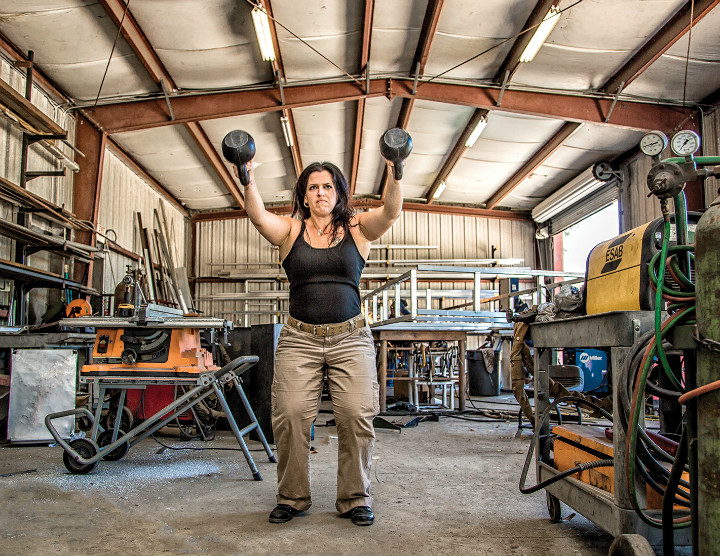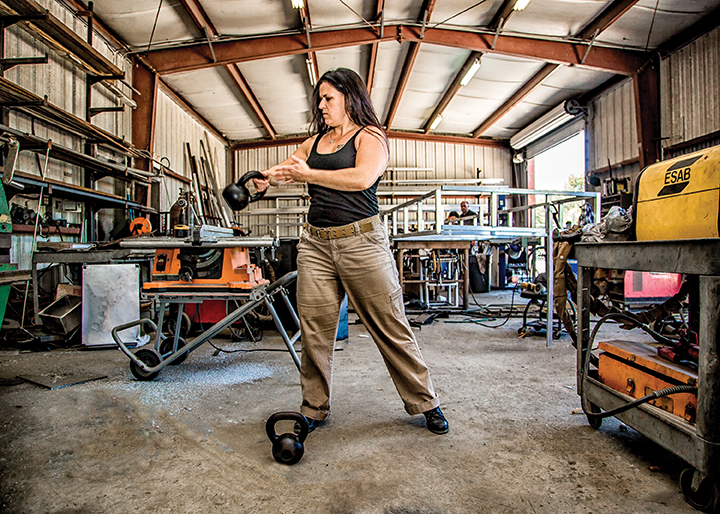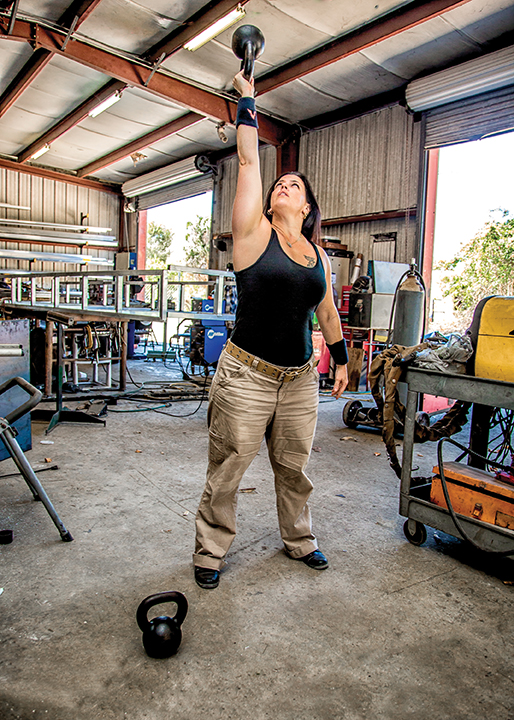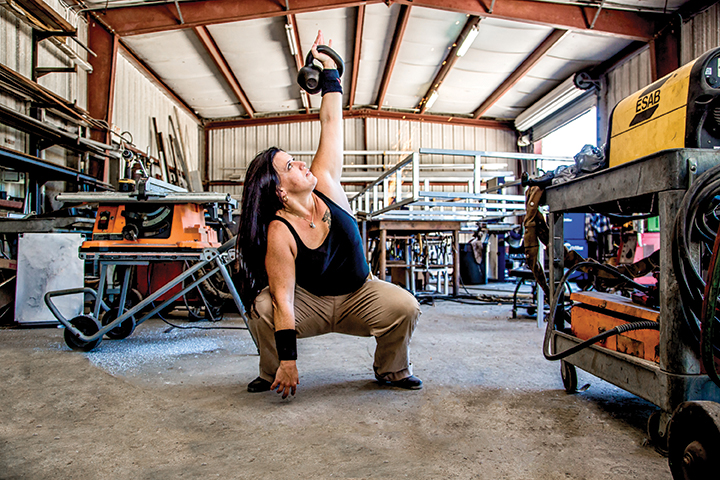Imported over a decade ago from the Soviet Union, kettlebell training is getting lots of love stateside for its efficiency in building strength, power, and lean muscle.
As one of the fastest-growing and most unconventional training methods out there, kettlebell training has been a staple in Russian Olympic athletes’ regimens for over a century. Now it has finally caught on in America. From competitive lifting to hardstyle lifting (high intensity with few repetitions), kettlebells can be found at most gyms these days and are a unique alternative to traditional dumbbell lifting.
But what can you do with them other than just standard swings? Well, a lot, actually! Kettlebells are quite versatile, so only your imagination can limit the variations of exercises. Besides adding extra intensity to any strength-training workout, they’re a great way to burn body fat and build lean muscle. Also, they’re much more challenging than your garden-variety dumbbells; the thick grip and heavy, low-hanging bell make it harder to control (which makes your core and entire body work harder, thus burning more calories).
But before you ever start swinging, keep this safety tip in mind: Kettlebell exercises can be dangerous and cause severe injury if you have not been properly trained on how to do them, so be sure to find a local kettlebell teacher whose certification you can verify. Proper form can prevent most injuries.
The Swing Squat
What you need: 2 kettlebells (lighter weights)
This compound move requires proficiency in two separate movements: a squat and suitcase swing. Make sure proper form is used in the squat. A suitcase swing is simply a double kettlebell swing, with the bells on the outside of the legs instead of being brought back in between your legs.
To incorporate both movements together, begin swinging the kettlebells in suitcase fashion. During the upswing, drop into the squat, maintaining proper squat form. The bells will come out to the front and you will drop below their height. Let the weight of the bells in the downswing assist you standing up from the squat and hinging at the hips for the backswing. Because this move requires both stability and balance, the weight of the kettlebells should be fairly light until the feel of the movement gets comfortable.
Power tip: Incorporate this movement into your normal Tabata workout (20 seconds of work, 10 seconds of rest) for an added boost of intensity.
Side-to-Side Kettlebell Swing
What you need: 1 kettlebell (lighter weight)
This is a fairly simple alternative to the basic swing, but it packs a punch to core, low back, and shoulder workouts, and it also adds variety to any workout calling for swings. The side-to-side motion will be in front of your body, and the hand switch is on the outside of the body, as opposed to the centerline. Since you are following the weight of the bell, you might lean a little in the way the bell is moving, so make sure to stand tall and keep your arms and legs loose.
With the weight constantly in front, you may find yourself leaning forward. Keep your core tight; imagine pulling your belly button in to touch your spine. If the bell goes too high or too far out in the swing, you are most likely going to miss catching the kettlebell in the hand switch.
Make it a regression: Perform the side-to-side swing without the hand switch.
Make it a progression: Add a bell flip to the hand switch.
Pro tip: focus on the core while doing this exercise, and ALWAYS keep arms and legs relaxed!
The Clean
What you need: 1-2 kettlebells
A kettlebell clean is much different than your typical barbell clean. The object of the barbell clean is a vertical movement upward, while the kettlebell clean incorporates a swing.
Hike the bell back to begin the swing. Keep knees soft and muscles relaxed until you need to engage for the movement. This goes for the arms as well; they should not be tight or tense. Your free hand should be following your other hand.
Swing the kettlebell until it reaches about shoulder height and pull it into the body. Your upper torso should be arched slightly back, so the weight is right in line with your hips. If you stand straight up with the bell in the clean position, the bell weight will pull forward and could lead to lower back strain. The handle should be pulled in toward the center of your body, not closer to your shoulder or bicep. This is called the rack position. Incorrectly holding the bell could cause problems with shoulders and elbows.
Turn your hand as if you are reading a text message and then let the bell drop down. Follow the bell’s movement, hinging at the hip when the forearm hits the inner thigh.
The clean can be done with one or two kettlebells. A variation would be a dead clean, where it is the same movement without the swing. It is similar to the barbell clean in that the bell is pulled straight up and into the rack.]
Bottoms-Up Press
What you need: 1-2 Kettlebells
I love to challenge myself by adjusting the weight placement during various exercises, so a variation to the strict dumbbell or kettlebell press is to simply flip the kettlebell over. The weight should be directly over your fist, instead of resting on your wrist or forearm. Any bottoms-up movement takes a lot of grip and forearm strength, so don’t go too heavy if you aren’t certain of your grip (read: a kettlebell to the arm is painful).
When performing the press, make sure to keep the bells out in front of you. Protect your shoulders and don’t press bells on the outside of your body. Like with all kettlebell exercises, keep core muscles tight. This is not a fast movement — slow and steady works best.
Sots Press
What you need: 1-2 kettlebells
If this is new to you, stick with one kettlebell. Sots presses with kettlebells can have all kinds of variations and all levels of difficulties. With a basic Sots press, clean the kettlebell and hold in the rack position. Squat down, making sure good form is intact. Strict press the bell overhead and bring it back down into the rack position, then stand back up. Make sure your weight is in your heels in the squat position and your back is flat.
Want a progression? Add a bicep curl after the press in the squat position. For an even bigger challenge, use two bells and alternate the movements (curl one bell while pressing the other). Always keep your eye on the weight that is above you.
Want more variety in your workout? Read this:
Manual Treadmill Could Be What You Need
The Pilates for Athletes Workout






